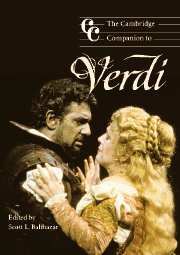Book contents
- Frontmatter
- Part I Personal, cultural, and political context
- 1 Verdi's life: a thematic biography
- 2 The Italian theatre of Verdi's day
- 3 Verdi, Italian Romanticism, and the Risorgimento
- Part II The style of Verdi's operas and non-operatic works
- Part III Representative operas
- Part IV Creation and critical reception
- Notes
- List of Verdi's works
- Select bibliography and works cited
- Index
2 - The Italian theatre of Verdi's day
from Part I - Personal, cultural, and political context
Published online by Cambridge University Press: 28 September 2011
- Frontmatter
- Part I Personal, cultural, and political context
- 1 Verdi's life: a thematic biography
- 2 The Italian theatre of Verdi's day
- 3 Verdi, Italian Romanticism, and the Risorgimento
- Part II The style of Verdi's operas and non-operatic works
- Part III Representative operas
- Part IV Creation and critical reception
- Notes
- List of Verdi's works
- Select bibliography and works cited
- Index
Summary
Within Verdi's long life and career, Italy witnessed two Wars of Independence (1848–49, 1859–60) and a social and political revolution: in 1861, the previous collection of small absolutist states became a single constitutional monarchy which subsequently enjoyed decades of rapid economic and civic development (particularly in the north) resulting from bourgeois liberalism. The theatrical world, with Verdi in a leading role, experienced corresponding changes: by the time of Falstaff, almost none of the system in which Verdi began his career – one that belonged essentially to the previous century – remained intact. To understand better Verdi's influential relationship to the opera industry and its gradual restructuring within a more modern environment before and after Italian unification, we first must examine the operatic world of 1825–40.
Although the peninsula was united by little more than an elite language written and spoken by educated citizens (and then only on formal occasions), the economic and cultural phenomenon of the “opera in musica” had become a central element of Italian identity and increasingly homogeneous since the mid-seventeenth century. Operatic style was based on widely known literary, musical, and theatrical conventions; while they differed from genre to genre and changed gradually over time, they nonetheless satisfied audience expectations and accelerated the composer's output. Operatic performances were widespread, and a growing number of theatres were open at various times of the year in both cities and smaller towns: eighty-two could boast working theatres in 1785–86 compared with forty at the end of the seventeenth century; one hundred and seventy-five different opera seasons were offered in 1830, around fifty more by 1840.
- Type
- Chapter
- Information
- The Cambridge Companion to Verdi , pp. 15 - 28Publisher: Cambridge University PressPrint publication year: 2004
- 2
- Cited by



